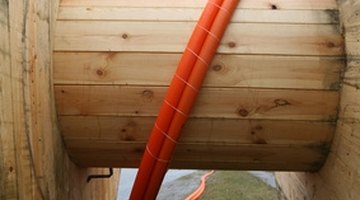Types of Plastic Used to Insulate Wire
Electrical wires need jacket insulation to protect them from the elements and other stresses. Plastic is one of the most common materials used to insulate electrical wires and conductors. It is preferred over other materials for its good moisture resistance, flexibility and insulating properties. Different types of plastics are used as insulating material, each one formulated to meet industrial and technical specifications.
Thermoplastic

According to Ray C. Mullin in the book "Electrical Wiring Residential: Based on the 2005 National Electric Code," thermoplastic insulation is the most common plastic insulation. It is a flexible type of plastic that melts when heated and can easily be reshaped. Alternatively, the plastic stiffens and hardens at temperatures below 14 degrees Fahrenheit. The most common types of thermoplastic insulation are THW, THHW, TW, THWN and THHN.
PVC
PVC, or polyvinyl chloride, is a type of plastic mix made by combining resin, fillers, pigments, lubricants and plasticisers. A wide range of PVC compounds can be made by combining different quantities of ingredients, with each individual compound exhibiting diverse electrical and physical properties. PVC plastic insulation is flexible, easy to process and bend and has flame-resistant properties. It exhibits excellent electrical insulation and resists bad weather, chemicals, oil and grease. The plastic is chemically stable and has a density that ranges between 1.32 to 1.42g per cubic cm. According to Francesco La Mantiain the "Handbook of Plastics Recycling," the two most important types of PVC are amorphous particle PVC and semicrystalline PVC.
Polypropylene
Polypropylene is a thin, lightweight insulating plastic compound that has good abrasion resistance, tensile strength and heat resistance. It has a lower dielectric constant and specific gravity than polyethylene, a similar plastic material. Other properties that make polypropylene suitable for cable insulation include good chemical resistance, moisture resistance, excellent impact strength and good creep resistance. It is suitable for high-frequency cables and retains its fundamental properties under various stresses. The three most common types of polypropylene include atactic polypropylene, syndiotactic polypropylene and isotactic polypropylene.
Polyethylene
Polyethylene is a tough general-purpose insulating cover that provides good resistance to moisture and chemicals and exhibits good brittleness at low temperatures. It is suitable for high-frequency electrical conductors and resists temperatures up to 1,652 degrees Fahrenheit (900 degrees Celsius). According to Gennadii Efremovich Zaikov, A. L. Bouchachenko and V. B. Ivanov, low-density polyethylene (XLPE) is the most common type of polyethylene insulation applied on high-frequency power cables.
References
- "Handbook of Plastics Recycling"; Francesco La Mantia; 2002
- "Electrical Wiring Residential: Based on the 2005 National Electric Code"; Ray C. Mullin; 2004
- "Polymer Aging at the Cutting Edge"; Gennadii Efremovich Zaikov, A. L. Bouchachenko and V. B. Ivanov; 2002
Writer Bio
Natasha Gilani has been a writer since 2004, with work appearing in various online publications. She is also a member of the Canadian Writers Association. Gilani holds a Master of Business Administration in finance and an honors Bachelor of Science in information technology from the University of Peshawar, Pakistan.
Photo Credits
- electricity wire image by jeancliclac from Fotolia.com
More Articles



